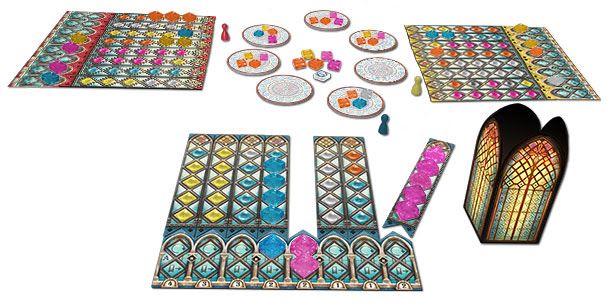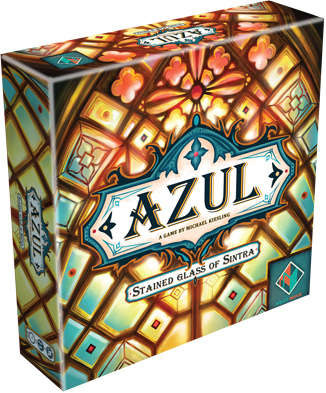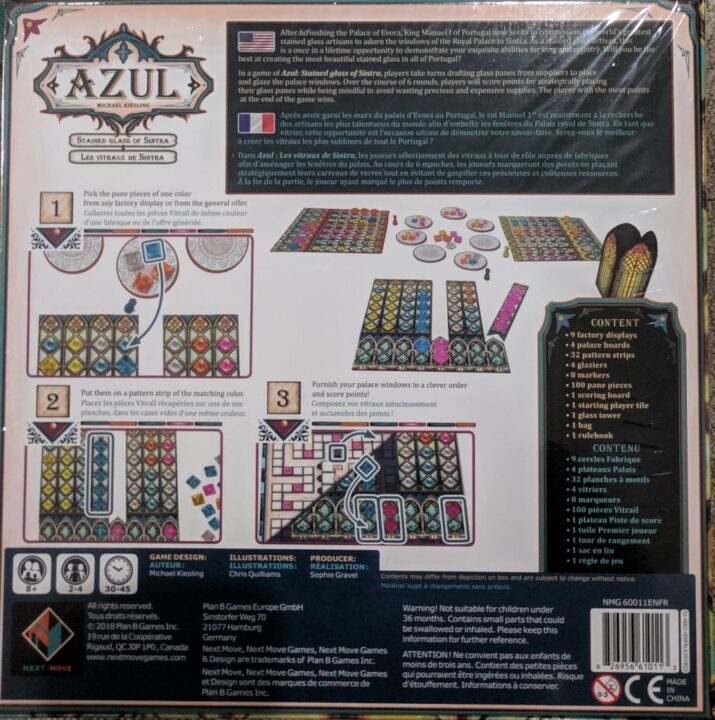Overview
Welcome to our board game table where today’s masterpiece for review is Azul: Stained Glass of Sintra. Dive with me into the vibrant world of window crafting where every decision counts. In my blend of personal gameplay anecdotes and a deeper look into mechanics, I’ll guide you through the strategic depth of tile drafting, intricate player interactions, and the welcoming learning curve of the game, all aiming to draw a clear picture of what makes this game tick. So, prepare your palette of colorful glass as we explore the beauty that lies in this exquisite dance of minds and chance. Let’s touch the sapphire skies and delicate azures as we construct our stained glass marvels!
How It Plays
Welcome to the vibrant world of Azul: Stained Glass of Sintra. As we saunter through this review, let’s lay down the colored panes and framework of how this artistic title is played.
Setting Up
Setting up is a breeze; players each get a board representing a stained glass window, and randomly-colored tiles are placed in factories in the center. You must strategize from these common pools to assemble the most beautiful glass panels.
Gameplay
Dive into a satisfying process of selecting tiles from factories or the center. Mastering drafting techniques creates rippling effects that challenge opponents’ plans. Draft prudently to avoid waste, which incurs penalties—precision is everything.
Winning the Game
Points are scored through clever placement and completing patterns on your display. After all rounds complete, high score captures the win. Simple to learn but tough to master, Azul encourages players to weave strategy with aesthetics.
This tile-crafting journey proves itself to be as strategic as it is stunning, making it an exemplary addition to the game night rotation.
Want to know more? Read our extensive strategy guide for Azul: Stained Glass of Sintra.
Masterful Mosaic Maneuvers: Tile-Drafting Mastery
In every gaming session of Azul: Stained Glass of Sintra, I’m reminded of the sheer brilliance that is tile-drafting. This is not just about picking what’s prettiest; oh no, it’s a delicate dance of strategy and foresight.
Evolving Strategy
Initially, I was simply charmed by the colorful aesthetic but quickly realized there’s a strategic depth rivaling chess. ‘Which tiles do I grab, forcing my friends to adapt?’ a question I often mumble while drafting. Each decision cascades, potentially setting me up for future rounds or leaving me vulnerable.
Adapt or Perish
My strategy evolves with the game state. Recalling a session where I pivoted mid-game due to an opponent’s unexpected move, I can attest that adaptability is key. Truly, tile-drafting in Azul: Stained Glass of Sintra Review involves predicting moves, much like a grandmaster plots his. Each playthrough has taught me that no two games are the same, with the depth coming from the seemingly simple choices twined with the complexity of human behavior.
Apart from the strategic tussle, tile-drafting sets the stage for a riveting gambit of player interactions—but that’s a discussion for the next section.

The Dance of Drafting Duelists
In every play of Azul: Stained Glass of Sintra, there’s an undercurrent, a silent tug-of-war between participants. It’s the quintessential player interaction that thrives on anticipation and strategy. I recall sessions where lighthearted banter quickly escalated into intense focus, as we vied for the most advantageous tiles.
Predictive Ploys
Undoubtedly, Sintra elevates player interaction through its draft. Deciphering opponents’ patterns forms the crux of its tension. Each choice is a calculated gamble, a probe into your adversary’s intent, making the board a battlefield of wits. I particularly love those ‘gotcha’ moments, when you snag the piece your friend so desperately needed.
Potential Pitfalls
Thankfully, confrontation isn’t hostile but wrapped in a poker-faced pursuit of patterns. Those sessions often end with a crescendo of satisfaction, even when edging out close competitors in this vibrant, visual feast. And speaking of visuals, they effortlessly segue to the aesthetic elegance that awaits us in the conversation about learning curve accessibility.

Easily Shaping Strategic Skills
First Impressions: When I first encountered Azul: Stained Glass of Sintra in our weekly game night, the rules seemed transparent, much like the beautiful panes in the game. Surprisingly, newcomers were mastering turns after a few rounds, indicating its welcoming learning curve.
Depth Over Time: Furthermore, as we delved deeper over multiple sessions, I discovered layers of tactical depth which subtly unfolded. The accessibility didn’t quench the strategic thirst of seasoned players yet allowed rookies to step in on equal footing.
This duality makes Azul: Stained Glass of Sintra a firm recommendation for its elegant balance of simplicity and depth.

Conclusion
In wrapping up this review, Azul: Stained Glass of Sintra stands out as a game that strikes a beautiful balance between simplicity and strategical depth. Its elegant tile-drafting mechanic intertwined with the unpredictability of player interaction makes each playthrough a fresh challenge. The gentler learning curve for newcomers and sufficient complexity for session veterans ensure that it appeals to a broad audience. Whether you’re looking for an engaging family night choice or a filler for your next game meet-up, Azul fits the bill effortlessly. This game confidently earns my recommendation for its ability to weave strategic gameplay into a harmonious experience that appeals across the spectrum of board game enthusiasts.



